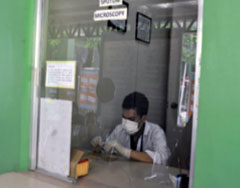Biorisk reduction
 Laboratory personnel are expected to act responsibly and prevent exposing communities to biorisks. Credit: WHO/HM.DiasBiorisk reduction combines expertise and advice on high consequence pathogens with guidance and training on safe handling and control of disease agents that pose significant health risks, with potential for adverse economic impact and public concern.
Laboratory personnel are expected to act responsibly and prevent exposing communities to biorisks. Credit: WHO/HM.DiasBiorisk reduction combines expertise and advice on high consequence pathogens with guidance and training on safe handling and control of disease agents that pose significant health risks, with potential for adverse economic impact and public concern.
Biorisk management includes analysis of ways and development of strategies to minimize the likelihood of the occurrence of biorisks. The goal of biorisk reduction is to ensure that current scientific knowledge regarding viral hemorrhagic fevers, epidemic-prone orthopoxviruses, and emerging severe zoonotic diseases affecting humans, is maintained in order to apply the most appropriate guidance for treatment, control, and safety to mitigate the risks regardless of the source of the disease event.
Information resources
Recent publications
Biosafety and laboratory biosecurity
A Guide for Shippers of Infectious Substances, 2013
Guidance on regulations for the Transport of Infectious Substances 2013-2014
Biorisk Management Advanced Trainer Programme (BRM ATP)
Interim Recommendations for Laboratory Biorisk Management
Policy documents
Laboratory Biorisk Management: Strategic Framework for Action 2012–2016
Links
Global Infection Prevention and Control Network (GIPC Network) launch
Infection prevention and control in health care
WHO Emerging and Dangerous Pathogens Laboratory Network (EDPLN)
GAR Natural Ventilation (NATVENT)
Responsible life sciences research for global health security
Related topics
Biohazard, see biosafety
Collaborating centres
Ministry of Health, Saudi Arabia
National Blood Bank, Jordanian Ministry of Health
King Abdulaziz Medical City, King Fahad National Guard Hospital


